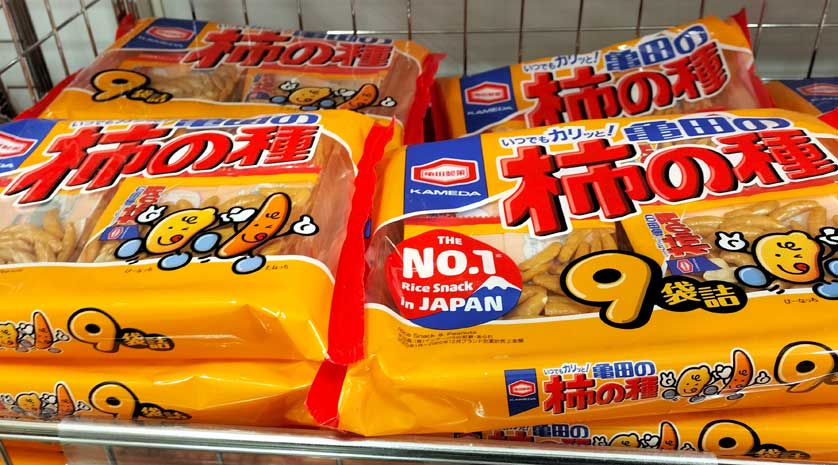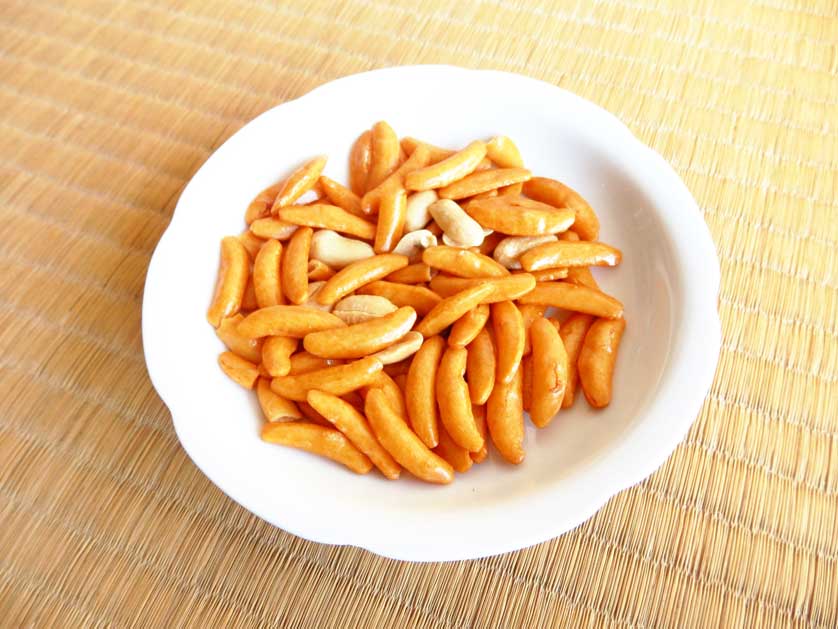Japanese Rice Crackers Kaki no Tane 柿の種
 |
| Packs of Kameda Kaki no tane rice crackers at a Japanese supermarket |
Kaki no tane translates as "persimmon (kaki) seed". In this case, however, it's the name of a particular kind of Japanese rice cracker somewhat resembling actual persimmon seeds in size, shape, and color.
The baked crackers, made of rice, are coated with a mixture of typical Japanese ingredients like soy sauce, bonito flake flavor, and, most importantly, chili. So, they are on the spicy side but not really red pepper hot.
To further mitigate their spiciness, they are today typically sold in a mix with roasted peanuts in a 7:3 ratio: 70% Kaki no tane, 30% peanuts.
As it goes with those little snacks, you open a mini pack to have a little thing to eat while you have a beer, watch a movie, or work on the computer - and when you look up, you discover that you are already well into your third mini pack. Once you start eating them, it's difficult to stop.
 |
| A pack of Kameda Kaki no tane contains six or nine mini packs |
History of the Snack
Senbei, Japanese rice crackers, date back to the Nara period (710 - 794), a time of great innovations, often inspired by China. Many different styles of senbei developed over the centuries but basically, senbei remained round, flat and had a diameter of about 3 to 5 centimeters. Senbei were and are usually eaten with a cup of green tea in an afternoon setting.
The kaki no tane have, however, their own legend. A man named Yosaburo Imai ran a typical senbei store in Nagaoka in rice-rich Niigata Prefecture in the 1920s when he hired a young man from Osaka. That young man, unnamed in the annals of senbei lore, taught Imai the Kansai style of making senbei - using a different type of rice and coating the senbei with salted, sugared soy sauce, bonito flakes thrown in, and, most importantly, plenty of chili pepper. Using the Kansai recipe, Imai's business grew rapidly.
One day in 1923, Imai's wife inadvertently stepped on the senbei molds, breaking the senbei inside into small oval-shaped pieces.
Imai sold the broken senbei anyway, apologizing to every customer. One customer told him: "They are great! They look like persimmon seed!" Indeed, the batch sold very quickly. People asked for more of the same.
That gave Imai the idea to pursue the making of persimmon seed-shaped senbei. In 1925, he introduced the first Kaki no tane as a commercial product.
As successful as his Kaki no tane were right from the start, Imai didn't patent his creation and the recipe quickly leaked out. Kaki no tane became the generic term for persimmon seed-shaped senbei and many manufacturers started to produce them.
Kameda Kaki no tane
Today, Niigata City-based manufacturer Kameda Seika is by far the largest producer of Kaki no tane. On some of their packs (but not all of them) they print in English their proud claim "The No.1 Rice Snack in Japan" over an image of Mount Fuji.
Kameda Kaki no tane come in packs containing either six or nine 28-gram mini packs of the rice cracker / peanut mix.
In fact, when the mix was introduced in the 1950s, it was called kakipea - a word combination of kaki (persimmon) and pea, short for peanuts.
By now, however, the Kaki no tane / peanut mix has become the standard. So, it doesn't say kakipea on the packages anymore, it only says "Kaki no tane".
Of course, it's still possible to buy packs of Kaki no tane without any peanuts in them.
 |
| Kameda Kaki no tane with peanuts ready to eat |
Other Varieties
While the soy sauce / chili coating delivers the classic taste of Kaki no tane - still having by far the largest market share - other varieties of Kameda Kaki no tane are available as well. The most famous and most commonly available of those are the green Wasabi Kaki no tane which are really, really spicy. They come without any peanuts mixed in, of course.
Ume (Japanese plums, fruits closer to apricots than Western plums) would seem to provide a perfect taste variation for Kaki no tane. They do, in the form of the Kameda Ume Shizo Kaki no tane.
In collaboration with the Meiji Chocolate Company, Kameda even offers two kinds of sweet chocolate-coated Kaki no tane: Milk Chocolate & White Chocolate, a mix of black and white choco rice crackers as well as Choco & Almond, a mix of milk chocolate-coated Kaki no tane and roasted almonds. These are the ones sold nationwide.
Kameda also cooperates with regional manufacturers providing coatings featuring classic tastes associated with the respective region - with the product sold only in that region: Matsuo Lamb Meat in Hokkaido, Garlic in Tohoku, White Shrimp in Hokuriku, Sakura Shrimp in Shizuoka, extra hot Shima Chili in Okinawa. An incomplete list for sure.
The gold standard however remains the by-now classic soy sauce / chili Kaki no tane mix with roasted peanuts. You can find them in every Japanese supermarket. You can also order them from Goods from Japan.
 |
| A nine mini pack package of Kameda Kaki no tane |
Buy Kaki no Tane
Purchase Kameda Kaki no Tane 9-Pack from GoodsFromJapan.
Related
Japanese Mortar & Pestle Suribachi & Surikogi
Sancho Japanese Mountain Pepper
by Johannes Schonherr
© GoodsFromJapan.com
